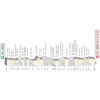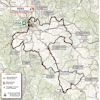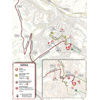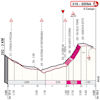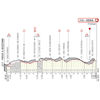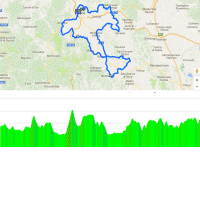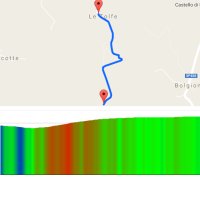Starting from Siena, the riders enter a race with medieval characteristics. They navigate 63 kilometres of Tuscan gravel, or ‘sterrati’. There are eleven sectors, the first of which is a solid way to get warmed up to all the hardship ahead. It’s 2.1 kilometres long, virtually flat, and perfectly straight.
Appearing at kilometre 25, sector 2 serves the pilots a more accurate taste of what’s ahead – 5.8 kilometres long and occasionaly kicking up to 10%. Following two flat to descending sterrati – respectively 4.4 and 5.5 kilometres – the Strade Bianche tackles the first climb on tarmac. It leads to the fortified town of Montalcino.
On to sterrato 5 and in its wake sector 6. An enchanting dust road in itself, with fields and forest left and right, sterrato 5 is – at 11.9 kilometres – the longest sector of the day. Hardly time for a breather, as there is merely 1 kilometre on tarmac before the 6th gravel road appears. This one is 8 kilometres long and throws in extreme bike handlings skills. It meanders on winding roads through the Tuscan countryside and includes both climbing and descending.
By now, the riders are halfway. After roughly 11 kilometres on smooth asphalt the 7th sterrato is 9.5 kilometres long, while running mostly uphill. It goes up and down in the first part and ends with a twisting climb before meeting the tarmac again.
At kilometre 130 the endgame begins on the Monte Sante Marie climb. At 11.5 kilometres, sector 8 is arguably the toughest of all sterrati. Most of the gravel points uphill, but the strip features some tricky descents as well. Last year, Tadej Pogacar launched a solo attack in this phase of the race, only to be seen again in Siena.
Following a lumpy intermezzo on asphalt – which may sound better than it actually is, as most riders will be hanging on the ropes – the shortest sterrato of the day adds 800 metres on gravel to the mix. It’s pepped up with a double digit gradient ramp before hitting the tarmac again in Vico d’Arbia.
It does not take long before the Strade di Colle Pinzuto appears, a 2.4 kilometres sector that will weary the legs still further. It opens with a 15% ramp and keeps climbing gradually all the way until the end. Hairpins are easing the gradients, while simultaneously causing loose gravel.
The last sterrato of the day is the illustrious Le Tolfe strip. Bike handling skills and relatively fresh legs are essential, as the 1.1 kilometres long sector opens with a short descent and closes with 18% gradients.
There are 12 kilometres remaining when the riders pass the hilltop chapel in Le Tolfe. The winding road on the run-in to Siena favours attackers, as chasers will have difficulty pinpointing them.
With 5 kilometres remaining the road goes downhill, only to go vertical again – quite literally – in the last kilometre. Entering the city walls of Siena, a 16% sector on rough and large stone slabs welcomes the riders. The Via Santa Caterina climb is 500 metres long and averages 12% before a right turn onto flat roads precedes a left and another right turn onto the Piazza del Campo, Siena’s iconic square resembling a theatre.
Ride the route yourself? Download GPX Strade Bianche 2023.
Other interesting reads: results and start list 2023 Strade Bianche.
Strade Bianche 2023: routes, profiles, more
Click on the images to zoom
